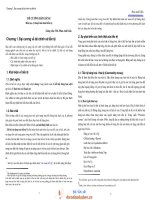Thuyết trình môn lý thuyết tài chính THE MONETARY POLICY AND AGGREGATE DEMAND CURVES
Bạn đang xem bản rút gọn của tài liệu. Xem và tải ngay bản đầy đủ của tài liệu tại đây (1.99 MB, 30 trang )
Chapter 22:
THE MONETARY POLICY AND AGGREGATE
DEMAND CURVES
Instructor: Prof. And Dr. TRAN NGOC THO
Members of group:
NGUYEN THU TRANG
NGUYEN HOANG HUNG
PHAM TRUC PHUONG
The Federal Reserve and Monetary Policy
Central banks throughout the world use a very short-term interest rate as their primary policy tool.
The Federal Reserve conducts monetary policy via its setting of the federal funds rate.
When it provides more reserves, banks have more money to lend to each other, and this excess liquidity causes the
federal funds rate to fall. When the Fed drains reserves from the banking system, banks have less to lend and the
shortage of liquidity leads to a rise in the federal funds rate.
The Federal Reserve and Monetary Policy
The federal funds rate is a nominal interest rate, it is also the real interest rate that affects net exports and
business spending, thereby determining the level of equilibrium output.
How does the Federal Reserve’s control of the federal funds rate enable it to control the real interest rate,
through which monetary policy impacts the economy?
The Federal Reserve and Monetary Policy
Changes in nominal interest rates can change the real interest rate only if actual and expected inflation
remain unchanged in the short run.
Because prices typically are slow to move—that is, they are sticky—changes in monetary policy will not
have an immediate effect on inflation and expected inflation.
When the Federal Reserve lowers the federal funds rate, real interest rates fall; and when the Federal
Reserve raises the federal funds rate, real interest rates rise.
The Monetary Policy Curves
The monetary policy (MP) curveindicates the relationship between the real interest rate the central bank
sets and the inflation rate
The Monetary Policy Curves
An example of a monetary
policy curve MP in which
r= 1.0 and λ= 0.5:
r = 1.0 + 0.5π
The Taylor Principle: Why the Monetary Policy Curve Has an
Upward Slope
To stabilize inflation, monetary policymakers follow the Taylor principle, in which they raise nominal rates by
more than any rise in expected inflation
Real interest rates rise when there is a rise in inflation.
An increase in inflation would lead to a decline in the real interest rate, which would increase aggregate
output, in turn causing inflation to rise further, which would then cause the real interest rate to fall even
more, increasing aggregate output.
Shifts in the MP Curve
The Federal Reserve is said to tighten monetary policy when it raises real interest rates, and to ease it when it lowers real interest rates.
Changes in monetary policy (autonomous changes) => shift the
The Taylor principle–driven changes (which are called automatic
monetary policy curve
adjustments to interest rates) => movements along the monetary
policy curve
Ex: To lower inflation they could increase r by 1%, and so raise the real interest rate at any given inflation rate, what we will refer to as an
autonomous tightening of monetary policy. This autonomous monetary tightening would shift the monetary policy curve upward by 1% from MP1 to
MP2.
Ex: If the economy is going into a recession, monetary policymakers would want to lower real interest rates at any given inflation rate, an
autonomous easing of monetary policy, in order to stimulate the economy and also to prevent inflation from falling. Result in a downward shift in
the MP curve, from MP1 to MP3.
Aggregate demand curve
The MP curve demonstrates how
central banks respond to changes
in inflation with changes in
interest rates.
The relationship between the
The IS curve we developed showed
inflation rate and aggregate
that changes in real interest rates,
output when the goods market is
in turn, affect equilibrium output
in equilibrium, the aggregate
demand curve
Deriving the aggregate Demand Curve graphically
Description
Panel
Panel (a)
Equation 2, we know that when the inflation rate rises from 1% to 2% to 3%, real interest rates rise
MP curve
from 1.5% to 2% to 2.5%
Panel (b)
Equation 13 of Chapter 20 (Y = 12 - r). As the real interest rate rises from 1.5% to 2% to 2.5%, the
IS curve
equilibrium moves from point 1 to point 2 to point 3 and aggregate output falls from $10.5 trillion to
$10 trillion to $9.5 trillion.
Panel (c)
Inflation rises from 1% to 2% to 3%, the equilibrium moves from point 1 to point 2 to point 3 in panel
AD curve
(c), and aggregate output falls from $10.5 trillion to $10 trillion to $9.5 trillion.
The line that connects the three points in panel (c) is the AD curve
Figure 4: Deriving the AD Curve
The MP curve in panel (a) shows that as inflation rises from 1.0% to 2.0% to 3.0%, the real
interest rate rises from 1.5% to 2.0% to 2.5%.
The IS curve in panel (b) then shows that higher real interest rates lead to lower planned
investment spending, and hence aggregate output falls from $10.5 trillion to $10.0 trillion to
$9.5 trillion.
Finally, panel (c) plots the level of equilibrium output corresponding to each of the three
inflation rates: the line that connects these points is the AD curve, and it is downward sloping
Deriving the aggregate Demand Curve graphically
The AD curve has a downward slope, because a higher inflation rate leads the
1
central bank to raise real interest rates, thereby lowering
planned spending, and hence lowering the level of equilibrium aggregate output
The AD curve can be written numerically as follows:
2
Y=11-0.5 π (3)
Shift the IS Curve
Shift the MP Curve
Factors that Shift the aggregate Demand Curve
Shifts in the IS curve
We saw in the previous chapter that six factors cause the IS curve to shift. It turns out that the same factors
cause the aggregate demand curve to shift as well:
1.
Autonomous consumption expenditure
2.
Autonomous investment spending
3.
Government purchases
4.
Taxes
5.
Autonomous net exports
6.
Financial frictions
Shifts in the IS curve
Figure 5 shows that any factor that shifts the IS curve shifts the aggregate demand curve in the same direction.
Therefore, “animal spirits” that encourage a rise in autonomous consumption expenditure or planned investment
spending, a rise in government purchases, an autonomous rise in net exports, a fall in taxes, or a decline in
financial frictions—all of which shift the IS curve to the right—will also shift the aggregate demand curve to the
right.
Conversely, a fall in autonomous consumption expenditure, a fall in planned investment spending, a fall in
government purchases, a fall in net exports, a rise in taxes, or a rise in financial frictions will cause the aggregate
demand curve to shift to the left.
Figure 5: Shift in the AD Curve from Shifts in the IS Curve
At a 2% inflation rate in panel (a), the monetary policy curve indicates that the real
interest rate is 2%. An increase in government purchases shifts the IS curve to the right in panel
(b).
At a given inflation rate and real interest rate of 2.0%, equilibrium output rises from $10
trillion to $12.5 trillion, which is shown as a movement from point A1 to point A2 in panel (c),
shifting the aggregate demand curve to the right from AD1 to AD2. Any factor that shifts the IS
curve shifts the AD curve in the same direction.
The Financial Crisis 2008
CHÍNH SÁCH TIỀN TỆ CỦA FED TRONG GIAI ĐOẠN
KHỦNG HOẢNG
Dorian Ford Prince, May 2010
Credit
The 2008 Financial Collapse
Crunch
Job Loss
Housing
Commodity Prices
Collapse
Global Economy
The Fed’s Monetary Policy Response to the Current
Crisis 2008
Use of traditional programs to provide liquidity
Policymakers conduct monetary policy through:
Open market operations
The discount rate
Reserve requirements
Điều chỉnh lãi suất
Lãi suất cho vay qua đêm liên ngân hàng được giảm từ 5.25% qua 6 đợt xuống chỉ còn 2% trong vòng chưa đầy 8 tháng. Lãi suất tiếp tục giảm xuống
mức 0.25% vào ngày 16/12/2008
Thị trường mở
Để ổn định thị trường và ngăn chặn cuộc khủng hoảng lan rộng, Fed đã lập tức bom vốn cho thị trường bằng 2 gói tín
dụng:
10/2008 Tung gói cứu trợ 700 tỷ USD nhằm tập trung cấp vốn trực tiếp cho các hang tài chính nhằm củng cố lại
thị trường tín dụng
3/2009 Thơng qua gói kích cầu trị giá 787 tỷ USD nhằm chi tiêu liên bang, cắt giảm thuế và tạo ra việc làm.
FED mua lại 1450 tỷ USD chứng khoán thế chấp và giấy tờ nợ do Ngân hang Fannie Mac, Freddie Mac phát hành,
giúp tăng tính thanh khoản của hệ thống
DỰ TRỮ BẮT BUỘC
10/2008, FED tiến hành trả lãi suất đối với số dư dự
trữ bắt buộc và dư nợ dư thừa của các ngân hàng. Việc
thanh toán lãi suất dự trữ cho phép FED mở rộng bảng cân
đối của nó khi cần thiết để cung cấp tính thanh khoản cần
thiết để hỗ trợ ổn định tài chính trong khi thực hiện chính
sách tiền tệ thích hợp.
Các cơng cụ mới của chính sách tiền tệ
TAF ( Đấu thầu cho vay kỳ hạn)
TSLF (Cho vay chứng khoán kỳ hạn)
PDCF ( Tín dụng cho trung gian tài chính hàng
AMLF ( Cho vay dựa trên thương phiếu được đảm bảo TS)
CPFF ( Quỹ thương phiếu)
MMIFF ( Công cụ cho nhà đầu tư trên Thị trường Tiền tệ)
TLAF (Cho vay dựa trên Chứng khoản được đảm bảo TS)









